
|
 |
 |
Escape through Time by Albert Lee and Rob Meyer Fire | Car | Plane | Ship 
Turnout Gear
Turnout gear took a great leap forward after World War II, when various organizations, foremost among them the National Fire Protection Association (NFPA), began issuing standards. The NFPA 1971 Standard on Protective Clothing for Structural Fire Fighting, for instance, called for an outer layer of flame-resistant fabric that would not be destroyed through charring, separating, or melting when exposed to 500°F for a five-minute period; a second layer to prevent moisture from penetrating through to the wearer; and a third layer to provide thermal insulation from radiant, conducted, and convective heat. Similar standards required gloves that could withstand flame, heat, vapor, liquids, and sharp objects, and footwear resistant to puncture, flame, heat, abrasion, and electrical current. In the 1980s, fire fighters began wearing turnouts made of three advanced materials: an outer shell material that raised the fire resistance level to about 1,200°F before the material began to break down; a layer that allowed the fire fighter to release moisture from inside the gear; and a fire-resistant synthetic material. Ideally, the latter will last about seven seconds in a flashover situation (when all combustible materials, including walls and floors, suddenly ignite) before catching on fire, which is usually enough time for someone to bail out of room. Further, it is self-extinguishing, meaning once out of contact with a fire, it will not continue to burn. These materials have become the standard for virtually all American fire departments.
Finally, NFPA 1982 called for Personal Alert Safety System (PASS) devices. Fire fighters trapped in smoke-filled buildings can become disoriented as they attempt to escape, sometimes leading to incapacitation from smoke inhalation. Using small motion detectors, PASS devices set off an alarm if motion is not detected after 30 seconds. back to top Helmets
At the turn of the century, aluminum helmets began to be popular. Though they were molded to look like leather helmets, they were cheaper. However, fire fighters quickly learned that these helmets had problems of their own. They not only conducted heat but electricity. As a result, a move back to leather helmets became inevitable. Strong enough to provide protection from falling objects, the leather helmet of the early 20th century shed water effectively and prevented objects from dropping down the back of the fire fighter's neck. Helmet design really took off after World War II. By 1979, when NFPA issued its Standard on Structural Fire Fighter's Helmets, designers were taking into consideration a mind-boggling array of factors, including impact force and acceleration; penetration, heat, and flame resistance; resistance to electrical current; effectiveness of chin strap and suspension system; flammability and resistance of ear covers; resistance of the face shield to heat and flame; and brightness and surface area of fluorescent markings.
back to top Respiratory Protection The first breathing devices used air pumped from a bellows through a hose to a "smoke mask" worn by the fire fighter. These devices were rarely used because of their bulky construction and unreliable performance. World War I led to the introduction of the gas mask proper. A few fire departments began to make these available to fire fighters in limited numbers, even though most did not protect well from carbon monoxide, and none worked in an oxygen-deficient atmosphere. In the 1920s, the U.S. Bureau of Mines commissioned the design and introduction of "rebreather" devices for mine rescue, and these were eventually adapted by the fire service. Rebreathers mixed a small stream of pure oxygen with exhaled air, which had been passed through chemicals that removed a portion of the carbon dioxide. These early rebreathers were better than their World War I predecessors but were clumsy, fragile, and difficult to control. In addition, the oxygen bottles for air supply were costly, and extensive training was necessary. As a result, they were seldom used by fire fighters. The World War I era saw the emergence of the first self-contained breathing apparatus, or SCBA (not to be confused with self-contained underwater breathing apparatus, or SCUBA). The devices featured metered compressed breathing air, which was sent directly into the face mask. As with the earlier rebreathers, however, there were drawbacks for fire fighters. SCBAs were expensive and uncomfortably heavy, adding to the fatigue and strain of fire prevention.
back to top Thermal Imaging
back to top Albert Lee is Originations Production Assistant and Rob Meyer is Online Production Assistant, respectively, at NOVA. Photos/Illustrations: (1) Museum of the City of New York; (2) SunnyCor Inc.; (3) L-W Book Sales; (4,6,7) NOVA/WGBH Educational Foundation; (5) Corbis Images, Hulton-Deutsch Collection. Escape Through Time | Skydive | Human Response Survivor Stories | Pioneers of Survival | Survival Strategies Resources | Teacher's Guide | Transcripts | Site Map | Escape! Home Editor's Picks | Previous Sites | Join Us/E-mail | TV/Web Schedule About NOVA | Teachers | Site Map | Shop | Jobs | Search | To print PBS Online | NOVA Online | WGBH © | Updated November 2000 |
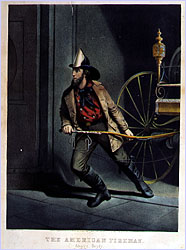 "Always Ready"—This Currier and Ives painting
illustrates the clothing of the early American fire
fighter. The mid-19th century gear consisted almost
entirely of wool, which was used both to ward off the
heat of the flames and the cold of the winter air.
"Always Ready"—This Currier and Ives painting
illustrates the clothing of the early American fire
fighter. The mid-19th century gear consisted almost
entirely of wool, which was used both to ward off the
heat of the flames and the cold of the winter air.
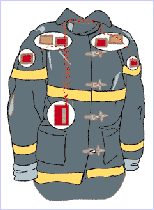 Modern protective clothing, or turnout gear, such as
the Smart Coat System above, incorporates sensors to
help the fire fighter assess dangerous conditions,
ranging from thermal saturation to the location of a
colleague who may be injured or lost in the black
smoke.
Modern protective clothing, or turnout gear, such as
the Smart Coat System above, incorporates sensors to
help the fire fighter assess dangerous conditions,
ranging from thermal saturation to the location of a
colleague who may be injured or lost in the black
smoke.
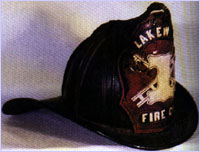 An essential part of any fire fighter's gear is the
helmet. Traditionally, the helmet was made of leather
strengthened by the use of combs, or leather seam
reinforcements. The helmet pictured above has 8 combs.
An essential part of any fire fighter's gear is the
helmet. Traditionally, the helmet was made of leather
strengthened by the use of combs, or leather seam
reinforcements. The helmet pictured above has 8 combs.
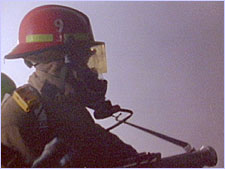 The modern firefighting helmet has a smaller brim but
uses ear covers and a flame-resistant hood (worn
underneath). Using high-tech plastics and composite
materials, the helmet must be puncture-proof and
resistant to heat, flame, electricity, and sudden
impacts.
The modern firefighting helmet has a smaller brim but
uses ear covers and a flame-resistant hood (worn
underneath). Using high-tech plastics and composite
materials, the helmet must be puncture-proof and
resistant to heat, flame, electricity, and sudden
impacts.
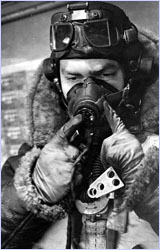 World War II pilots used oxygen breathing systems in
high-altitude flights, which led to the development of
open-circuit, positive-pressure firefighting SCBAs
(self-contained breathing apparatus).
World War II pilots used oxygen breathing systems in
high-altitude flights, which led to the development of
open-circuit, positive-pressure firefighting SCBAs
(self-contained breathing apparatus).
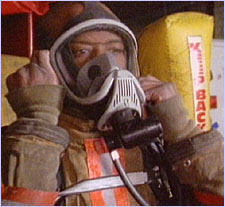 In 1981, the National Fire Prevention Agency issued a
standard on modern SCBA systems mandating positive
pressure airflow at 100 liters per minute and a
minimum service life of 30 minutes.
In 1981, the National Fire Prevention Agency issued a
standard on modern SCBA systems mandating positive
pressure airflow at 100 liters per minute and a
minimum service life of 30 minutes.
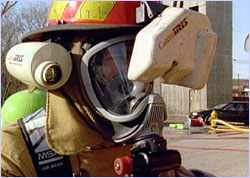 The use of thermal imaging cameras may improve the
ability of the future fire fighter to navigate in a
smoke-filled room to find potential victims or to
pinpoint areas in the walls or floors that may have
been weakened by the fire.
The use of thermal imaging cameras may improve the
ability of the future fire fighter to navigate in a
smoke-filled room to find potential victims or to
pinpoint areas in the walls or floors that may have
been weakened by the fire.